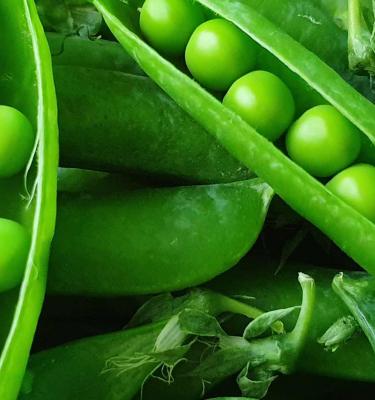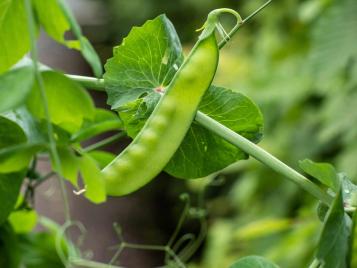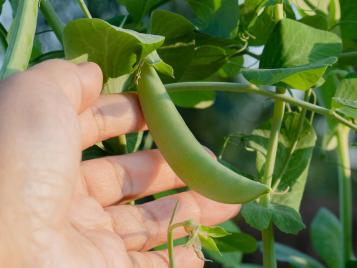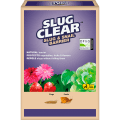

How to grow sugar snap peas
Sugar snap peas are a deliciously sweet, fun and quick-cropping vegetable to grow. They will produce a prolific amount of peas from even the tiniest space, and are a great way to involve kids in the garden. Kids love to eat these delicious peas straight from the pod, so don’t count on too many making it to the kitchen! Just provide water, food, compost, and sunlight, and you’ll have a harvest of tasty healthy snacks in no time.
Varieties of sugar snap peas you can grow
Sugar snap peas are different to other peas as the entire swollen pea pod of a sugar snap pea can be eaten raw. Garden peas have a thicker pod which isn’t so palatable, so the peas need to be removed from the pod first. The entire flat pod of a mange tout can be eaten, but they can be a little tough, so should be steamed or marinated for a while first.
We really like the following sugar snap peas:
- Delikett. A prolific producer of very sweet sugar snap peas, ‘Delikett’ has been awarded the prestigious RHS Award of Garden Merit (AGM). These plants grow to just 60cm (2') tall and are compact, making them perfect for a container or small patch of soil.
- Sugar Ann. One of the fastest maturing cultivars, ‘Sugar Ann’ will begin to produce peas in under two months from sowing. It grows to 75cm (2 ½') tall, with heavy showers of small and sweet pods.
- Sugar Lace. A good type to grow where powdery mildew is a problem, showing resistance to this nuisance disease. This cultivar puts most of its energy into producing peas rather than leaves, producing super juicy pods.
Sugar snap peas are a good source of Vitamin C. Their sweetness and ease of eating makes them a healthy addition to any lunchbox!

Essential equipment for growing sugar snap peas
To grow sugar snap peas you will need:
- Small pots at least 9cm (3") deep.
- Miracle-Gro® Peat Free Premium Fruit & Vegetable Compost, or all purpose compost such as Miracle-Gro® Premium All Purpose Compost.
- Dibber.
- Sugar snap pea seeds.
- Garden rake (if growing in the ground).
- Container (if growing in pots).
- Watering can.
- Plant food, such as Miracle-Gro® Performance Organics Fruit & Veg Granular Plant Food.
- 1m (3') tall supports (sturdy sticks, trellis, or canes with netting).
- Levington® Composted Bark.
How to grow sugar snap peas
You can sow sugar snap peas from March - April indoors or April - June outside as long as all risk of frost has passed. The cultivars we have recommended above grow to under 1m (3') tall, but some can reach 2m (6'), so make sure you check the packet first and use taller supports if needed.
How to sow sugar snap peas indoors
- Fill the small pots with compost, leaving 2-3 cm (1") between the top of the compost and the rim of the pot.
- Push 3-4 seeds into the compost in each pot, so that they aren’t touching each other. You might need to limit this to 2 seeds in small pots.
- Keep well watered, and prepare to move them outside when they are 12-15cm (4-5”) tall, from April onwards.
How to sow sugar snap peas outdoors
- Prepare the soil with a garden rake, removing weeds and evening out any large clumps of soil. If growing in pots, fill the container with compost, so that it is just 1cm (1/2”) below the rim of the container.
- Use the dibber to make a hole 2-3cm (1-1.5") deep for each pea.
- Fill each hole with water, place a pea seed in, and fill the hole with compost.
Supporting your crop
- Once peas have germinated, or after you have planted out the peas you started indoors, it’s time to add supports. These can be arranged in a row, or a wigwam arrangement shape.
- Insert twigs and sticks (being careful to avoid the delicate roots), a trellis, or canes with netting wrapped around, into the ground. Sugar snap peas climb using tendrils and need a roughly textured surface to scramble up.
- The supports you use should be strong enough to support the plants as they grow - make sure they don’t wiggle in the ground!
Caring for sugar snap peas
Make sure that your sugar snap peas receive lots of sun. Ideally this should be six hours or more each day, so check that they do not become overshadowed by other plants.
Shelter plants from strong winds, and keep well watered. Sugar snap peas need moist, well drained soil, so water them daily. Add a mulch of Levington® Composted Bark in early summer, to conserve moisture, which will help the plant to keep producing more pods.
Check that supports are firmly in the ground, securing them as needed. Occasionally a plant will veer away from the supports, so gently help it back towards them if needed.
Sugar snap pea plants will produce pods up until the first frosts. They are annual plants that you will need to sow each year. One of the many great things about them is that you can dry and save some of the seeds for using again next time.
Harvesting sugar snap peas

The earliest sown sugar snap pea pods will be ready by June. Wait until they have filled out and have a tubular shape, but before you can start to see the individual peas in the pod. Depending on the variety, they are likely to be 4cm (1.5") long, but pick them before they get to 8cm (3”) big as the pods then start to become fibrous.
- Once pea pods start to swell, they can be harvested. Hold the stem of the plant just above the pea pod, and gently snap the pod away.
- Feed the plants throughout the cropping season with Miracle-Gro® Performance Performance Organics Fruit & Veg Concentrated Liquid Plant Food.
- Sow more peas around the base of the supports every 2-3 weeks up until the end of June, to ensure a succession of peas to harvest.
Storing and cooking with sugar snap peas
You should eat sugar snap peas soon after picking them, for maximum sweetness. If you store them before use, place them in the salad drawer of the fridge.
Add fresh sugar snap peas to salads, whole or sliced, and washed but uncooked. They pair well with salad leaves, pak choi, radish, baby carrots and spring onions.
Mature pods that were picked a little late are better cooked before eating. They are great used in stir-fries alongside noodles and broccoli, or served as a side dish with new potatoes and a slice of quiche.
Sugar snap peas can be frozen for cooking at a later date. Blanche them by adding whole pods to a pan of boiling water for two minutes, before draining and plunging into ice cold water. You can then store in the freezer and add to pasta dishes and risottos.
Common Pests And Diseases
Sugar snap peas are susceptible to a number of pests and diseases. They are all better prevented rather than treated after an attack has started.
What is the white growth on the surface of my sugar snap pea leaves?
Powdery mildew can affect sugar snap peas in hot, dry weather. Keep plants well watered, avoiding touching the leaves with water. Some cultivars, such as ‘Sugar Lace’ and ‘Super Snappy’ have better resistance to powdery mildew, so try these if you have had problems in the past.
What has eaten my sugar snap pea seedlings?
Mice can eat the seeds of freshly planted sugar snap peas, leaving stalks scattered over the surface of the soil. Slugs and snails will eat any green part of the plant that they can reach, with only shiny, slimy trails to show. Start plants inside and move outside once they are big enough to fend off attacks from any of these culprits.
What is eating my sugar snap pea plants?
Pigeons will nibble the leafy foliage, stunting their growth before they can develop pods. Use secure netting to prevent pigeons reaching plants, removing it once plants start to flower. Hang shiny items nearby to confuse them and deter them from landing.




